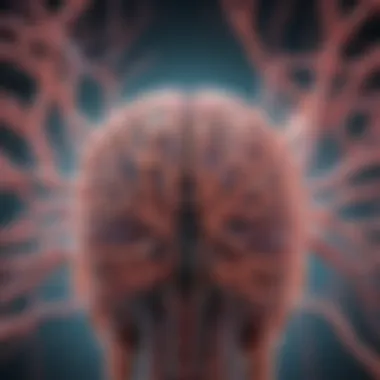Understanding the Complex Causes of Bipolar Disorder


Overview of Research Topic
Brief Background and Context
Bipolar disorder is a complex mental health condition characterized by significant mood swings. These may range from manic highs to depressive lows. Historically, the understanding of this disorder has evolved, with early theories primarily attributing its cause to emotional disturbances. However, contemporary research suggests a multifaceted etiology.
Genetic predispositions are critical, indicating that individuals with close relatives suffering from bipolar disorder have a higher likelihood of developing the condition themselves. Studies show that genetics can account for approximately 60 to 80 percent of the risk for developing bipolar disorder. Significant research has focused on identifying specific genes involved, but the picture remains incomplete.
Environmental factors also play a vital role. Life events such as trauma, chronic stress, and substance abuse can trigger or exacerbate symptoms in those already predisposed. The interaction between these external stressors and an individual's genetic makeup shapes the overall profile of the disorder.
Importance in Current Scientific Landscape
Understanding the etiology of bipolar disorder holds crucial implications for effective treatment methods. It enables researchers and clinicians to adopt a comprehensive approach incorporating both genetic screening and therapeutic interventions tailored to individual patient needs. As mental health awareness rises, so does the demand for effective treatments grounded in solid scientific understanding. A thorough examination of the various factors contributing to this disorder is critical for fostering future research and treatment developments.
Methodology
Research Design and Approach
The methodology employed in this investigation includes a systematic review of current literature. This design allows for a detailed examination of genetic studies, neurobiological assessments, and environmental impact analyses. Integrating diverse research findings offers a clearer view of the disorder's etiology.
Data Collection Techniques
Data collection primarily involves gathering information from peer-reviewed journals, clinical studies, and meta-analyses. Key databases such as PubMed and PsycINFO are valuable resources for obtaining high-quality data. Interviews with professionals in the field further enrich the insights shared in this article.
Understanding Bipolar Disorder
Understanding bipolar disorder is crucial as it serves as the foundation for comprehending its complex etiology. This multifaceted mental health condition presents significant challenges for those affected and the professionals who seek to provide support and treatment. By exploring the key components of bipolar disorder, one can appreciate the nuances that characterize its symptoms and development.
First, bipolar disorder is more than just mood swings; it encompasses varying intensities of emotional states that can impact daily functioning. Due to its diverse manifestations, many individuals may remain undiagnosed or misdiagnosed for years. Understanding the specific elements of bipolar disorder sheds light on the importance of early diagnosis, which can help in managing the condition effectively.
The benefits of understanding bipolar disorder extend to both the affected individuals and their support systems. Patients can recognize patterns in their behavior and emotions, which may aid in self-management strategies. Families can learn to identify symptoms and provide the necessary support, leading to a more stable and understanding environment.
Ultimately, a comprehensive grasp of bipolar disorder forms the basis for further discussions on genetic, environmental, and neurobiological influences. It is essential to view bipolar disorder through a holistic lens, taking into consideration both intrinsic and extrinsic factors. Understanding this disorder highlights its relevance to ongoing research and the importance of continued education among health professionals and caretakers.
Genetic Factors in Bipolar Disorder
The investigation of genetic factors in bipolar disorder is a cornerstone for understanding the multifaceted nature of this condition. Genetic research welcomes exploration into how hereditary elements influence not just the disorder's onset but also the variation in symptoms and responses to treatment. Knowing these factors is crucial for developing better diagnostic methods and targeted therapies. Understanding genetics can also offer insights into preventative measures and risk assessment, enhancing patient care.
Family Studies and Heritability
Family studies have consistently demonstrated that bipolar disorder has a notable heritable component. Twin studies in particular reveal that individual risk can significantly increase if a close relative has the disorder. For instance, the lifetime risk of bipolar disorder in the general population is about 1-2%, whereas this figure jumps to as high as 40% in identical twins.
Researchers often use these statistics to estimate heritability, suggesting that about 60-80% of the susceptibility to bipolar disorder can be attributed to genetic factors. Understanding this heritability can help in identifying at-risk populations, further enabling research into protective factors and familial support systems.
Candidate Genes and Genetic Variants
Research into candidate genes for bipolar disorder has identified several variants associated with its risk. Notable genes include CACNA1C, ANK3, and ODZ4. These genes are involved in several biological pathways, including neurotransmission and synaptic function. Variants in these genes may alter how the brain manages mood regulation, ultimately predisposing individuals to the disorder.
Gene-environment interactions are also significant. For example, certain genetic predispositions may only manifest when combined with environmental stressors, highlighting a more nuanced relationship between genetics and life experiences. This layer of understanding may lead to personalized treatments that consider both genetic makeup and environmental factors affecting patients.
Genome-Wide Association Studies


Genome-wide association studies (GWAS) represent an advancement in exploring the genetic architecture of bipolar disorder. GWAS analyze the entire genome to identify single nucleotide polymorphisms (SNPs) associated with the disorder. Recent studies have found numerous SNPs linked to bipolar disorder, thereby broadening the understanding of genetic influences.
These insights describe a complex interplay of multiple genes rather than a single genetic culprit. By identifying various regions of the genome that contribute to bipolar risk, researchers can formulate hypotheses about biological pathways involved, guiding future studies.
"Bipolar disorder is a complex condition influenced by intricate genetic networks and external factors, underscoring the need for comprehensive research."
Importantly, GWAS also pave the way for pharmacogenomics, which studies how genes affect individual responses to medications. This is particularly pertinent in bipolar disorder, where treatment outcomes can vary significantly among patients. By incorporating genetic profiling into standard practices, clinicians might enhance treatment efficacy and reduce adverse effects related to medications.
In all, the genetic components of bipolar disorder are being scrutinized vigorously, promising substantial advancements in understanding this complex mental health condition. This ongoing research can ultimately lead to more effective interventions and improved outcomes for those affected.
Environmental Factors Contributing to Bipolar Disorder
Understanding the environmental factors influencing bipolar disorder is crucial for a holistic comprehension of this mental health condition. These factors vary from individual stressors to broader societal influences, and they can interact with genetic predispositions in complex ways. By recognizing how environmental aspects contribute, we can better understand the onset and progression of bipolar disorder, as well as inform treatment approaches.
Impact of Stress and Trauma
Stressful life events and trauma hold significant weight in shaping mental health outcomes. Research indicates that significant stressors such as the loss of a loved one, relationship breakdowns, or financial difficulties can trigger episodes of mania and depression in susceptible individuals. The relationship between stress and bipolar disorder is bidirectional; while stress can precipitate episodes, the disorder itself can create a heightened sensitivity to stress. Thus, effective management of stress is critical for those with bipolar disorder.
Factors like childhood trauma, including physical or emotional abuse, also play a crucial role. Individuals with a history of traumatic experiences may exhibit a more severe course of bipolar disorder and a higher likelihood of rapid cycling between mood states. Therefore, therapeutic interventions that incorporate trauma-informed care are essential in managing the disorder and improving long-term outcomes.
"Stress not only contributes to the onset of bipolar episodes but may also exacerbate existing symptoms, highlighting the need for comprehensive management strategies.”
Substance Abuse and Its Role
Substance abuse commonly intersects with bipolar disorder, forming a complex co-occurring condition. Many individuals with bipolar disorder may turn to drugs or alcohol as a means of coping with their symptoms, which can lead to a worsening of their mental health. For instance, stimulants like cocaine and methamphetamine are notorious for triggering manic episodes, while alcohol often exacerbates depressive phases.
Research shows that about 60% of individuals with bipolar disorder also struggle with substance use disorders. This co-morbidity can complicate treatment plans and necessitate integrated therapeutic approaches that address both issues simultaneously. Education around the risks of substance abuse is fundamental for those diagnosed with bipolar disorder, as it can aid in preventing relapse and improve overall stability in mood.
Seasonal and Environmental Influences
Seasonal changes have been linked to fluctuations in mood for individuals with bipolar disorder. Many patients report experiencing heightened episodes of mania during the spring and summer months, while depressive episodes more commonly manifest in fall and winter. This seasonal pattern could be influenced by changes in light exposure, temperature, and social interactions associated with different seasons.
Moreover, geographical factors can impact mood stability. Individuals living in areas with limited sunlight may experience seasonal affective disorder (SAD), which can complicate the already intricate mood regulation seen in bipolar disorder. Consequently, ensuring that patients receive adequate light exposure and understanding their individual patterns can be beneficial in the overall management of bipolar disorder.
Incorporating an awareness of these environmental triggers into treatment plans not only aids in symptom management but can also empower individuals to make informed lifestyle choices that support their mental health.
Neurobiological Perspectives on Bipolar Disorder
Understanding the neurobiological aspects of bipolar disorder is critical for grasping how this condition manifests and progresses. It shifts the focus from mere symptoms to the underlying brain mechanisms that may predispose individuals to mood disorders. Research in this area gives insight into various factors, such as genetic predisposition and environmental triggers, and how they interact on a biological level. By examining neurobiological factors, we open a window into potential therapeutic targets that may alleviate the symptoms and improve the quality of life for those affected.
Brain Structures and Functioning
The brain exhibits structural and functional differences in individuals with bipolar disorder. Research shows that abnormalities can often be found in several key regions. For example, the prefrontal cortex, responsible for decision making and impulse control, may exhibit reduced volume or altered activity in affected individuals. Similarly, the amygdala, which plays a crucial role in emotional processing, tends to show differences in size and activity levels.
The significance of these findings lies in their potential contributions to mood dysregulation. The relationship between brain structure and functioning highlights how biological variations can lead to the mood swings characteristic of bipolar disorder.
Neurotransmitter Systems Involved
Neurotransmitters are chemical messengers that facilitate communication between neurons. In bipolar disorder, several neurotransmitter systems are found to be disrupted. The most notable include serotonin, dopamine, and norepinephrine.
- Serotonin has a role in mood stabilization. Low levels often link to depressive episodes.
- Dopamine is associated with reward and pleasure but can lead to mania when dysregulated.
- Norepinephrine influences arousal and alertness, contributing to the emotional highs and lows seen in bipolar disorder.
Understanding these neurotransmitter systems helps in pharmacological interventions. Many medications aim to balance these neurotransmitters, thus addressing the core biochemical imbalances that underlie the condition.


Neuroinflammation and Its Link
Recent studies suggest that neuroinflammation may play a significant role in bipolar disorder. Inflammatory markers are often found elevated in individuals with this disorder, pointing to a potential connection between inflammation and mood regulation.
"Emerging evidence indicates that treating inflammation may provide relief for some individuals suffering from mood disorders."
Neuroinflammation could affect neurotransmitter systems and brain structure, linking back to both the symptoms of bipolar disorder and its progression. Understanding this relationship opens up new avenues for treatment strategies, including anti-inflammatory therapies that could complement existing treatments.
By analyzing these neurobiological perspectives, we gain a more comprehensive understanding of bipolar disorder's complexity. Addressing these neurobiological concerns may lead to innovative treatment solutions not previously considered.
The Interplay of Genetic and Environmental Factors
The intricate relationship between genetic and environmental factors plays a crucial role in the development of bipolar disorder. Understanding this interplay helps to clarify how biological predispositions may be activated or exacerbated by external conditions. This topic is essential not only for grasping the etiology of bipolar disorder but also for informing effective prevention and treatment strategies. By recognizing the dual influences of genetics and environment, we can foster a more nuanced comprehension of this mental health disorder.
Gene-Environment Interactions
Gene-environment interactions illustrate how genetic vulnerabilities combined with environmental stressors can lead to the onset of bipolar disorder. Individuals can possess specific genetic traits that increase their risk for developing this condition. However, it is the environmental factors that often trigger these underlying biological predispositions. For instance, a person with a family history of bipolar disorder may not develop the condition unless they encounter significant stress, such as trauma or chronic illness. This interaction underscores the necessity for a detailed examination of both genetic vulnerability and external circumstances in assessing risk.
- Genetic Predisposition: Certain genes linked to mood regulation are associated with a heightened risk.
- Trigger Events: Stressful life events may trigger the disorder in genetically susceptible individuals.
Research continues to unravel these complex interactions, suggesting that understanding them could lead to more tailored therapeutic approaches.
Epigenetic Mechanisms
Epigenetics expands the discussion of genetic influences by exploring how environmental factors can modify gene expression. This means that certain experiences or exposures can turn specific genes on or off, impacting behavior and emotional regulation. In the context of bipolar disorder, epigenetic changes might help explain why two individuals with similar genetic backgrounds can experience the disorder in markedly different ways.
- Environmental Factors: Stress, diet, and other lifestyle choices can trigger epigenetic changes.
- Long-Term Effects: These changes may persist, affecting mental health even when environmental stressors are removed.
Understanding these mechanisms can lead to insights into potential interventions, emphasizing the importance of both genes and the environment throughout a person’s life.
Cultural Influences on Expression
Cultural factors significantly shape the expression and experience of bipolar disorder. Different cultures perceive mental health disorders in unique ways, affecting how individuals acknowledge and manage their symptoms. Cultural attitudes towards mental health can lead to varying degrees of stigma, support, and treatment access.
- Cultural Perceptions: Some cultures may view mood swings as a spiritual or moral issue, rather than a medical one.
- Support Systems: Cultural backgrounds play a role in the availability of community support and acceptance.
Recognizing these cultural influences is vital for developing effective, culturally competent treatment options that respect and integrate patients' backgrounds.
Bipolar Disorder Across the Lifespan
Understanding bipolar disorder within the context of the entire lifespan is crucial. The condition does not operate in isolation; it evolves through distinct life stages. Each phase of life offers unique challenges and manifestations of symptoms, influencing how the disorder is diagnosed and treated. Assessing bipolar disorder across various ages helps in tailoring interventions and support systems effectively.
The importance of recognizing developmental factors, particularly during adolescence, cannot be understated. This is a period when many mental health disorders, including bipolar disorder, commonly emerge. Early identification can make a significant difference in management and outcomes. Additionally, gender differences are notable in how the disorder presents and is perceived, influencing treatment strategies and social support.
The topics of developmental factors and gender differences serve as essential aspects in grasping the comprehensive nature of bipolar disorder.
Developmental Factors in Adolescents
Adolescents represent a unique demographic in the context of bipolar disorder. The onset typically occurs between the ages of 15 to 25. Early exposure to mood disturbances can lead to significant life implications, including disrupted education and strained relationships.
Several key factors influence the manifestation of bipolar disorder during adolescence:
- Hormonal changes: Hormonal fluctuations during puberty can exacerbate mood symptoms.
- Psychosocial stressors: Adolescence brings various stressors, from academic pressures to social dynamics, which may trigger episodes.
- Brain development: The adolescent brain undergoes substantial changes, affecting emotional regulation and risk assessment. This can lead to risky behaviors during manic phases.


Studies indicate that early recognition of bipolar symptoms can significantly improve long-term outcomes, emphasizing the need for awareness among parents and educators.
Additionally, prevention strategies should focus on creating supportive environments in schools and families. Mental health education can increase understanding and reduce stigma among teenagers and their peers.
Gender Differences in Presentation
Research indicates that bipolar disorder can present differently based on gender, influencing the approach to treatment and management. While both genders are affected, the way symptoms manifest can vary.
Men often experience:
- More frequent manic episodes.
- Their manic symptoms may be more aggressive and impulsive.
Women, conversely, may show:
- A higher incidence of depressive episodes.
- They often experience a greater impact from hormonal changes, particularly during menstrual cycles, pregnancy, and menopause.
Understanding these differences is important for clinicians. Gender can affect the type of medication prescribed and how psychotherapeutic interventions are designed.
Current Research and Future Directions
Understanding the etiology of bipolar disorder is a complex undertaking that requires continuous research and innovative methodologies. The focus on current research and future directions is essential for developing effective treatments and improving patient outcomes. This section will highlight critical elements, including new findings in treatment approaches, the incorporation of diverse research disciplines, and the implications for ongoing and future studies.
Innovative Approaches in Treatment
Recent advances in the treatment of bipolar disorder revolve around integrating technology with psychological and pharmacological strategies.
- Digital Therapeutics: Apps and online therapy platforms enhance accessibility and provide continuous monitoring of symptoms. These tools allow both patients and practitioners to track mood fluctuations and identify triggers more effectively.
- Personalized Medicine: Understanding the unique genetic makeup of individuals can lead to more tailored treatments. For instance, pharmacogenomic testing, which determines how a person responds to medications based on their genetic profile, is gaining traction.
- Neurofeedback: This technique aims to train individuals to self-regulate brain activity through real-time feedback. Initial studies indicate it may help manage symptoms.
- Combined Therapies: Techniques that merge psychotherapy with medication show promise. Cognitive Behavioral Therapy (CBT), alongside mood stabilizers, can improve patient adherence and outcomes.
Emerging research underscores the need to evaluate these innovative treatments rigorously. Assessing their efficacy and long-term benefits is crucial for establishing validated practices.
Integrating Findings from Various Disciplines
The complexity of bipolar disorder demands a multidisciplinary approach to research and treatment. By crossing disciplinary boundaries, insights from various fields can enhance understanding and lead to comprehensive treatment options. Here are some ways this integration occurs:
- Psychology and Neuroscience: Insights into brain function and emotional regulation can inform psychological techniques.
- Genetics and Psychiatry: Collaborative studies can reveal the genetic underpinnings of the disorder, leading to risk assessments based on family history.
- Social Sciences: Research into societal and environmental impacts can provide context regarding the prevalence and expression of the disorder across different cultures.
- Public Health: Understanding the implications of bipolar disorder on a population level can influence policy and resource allocation.
Using a collaborative approach fosters an environment where breakthroughs are more likely to occur, paving the way for innovative solutions to emerging challenges in bipolar disorder research.
"The future of bipolar disorder treatment lies in understanding the diverse factors that contribute to its onset while remaining open to new methodologies and technologies."
Ending
Understanding the etiology of bipolar disorder is critical for several reasons. This involves delving into the genetic, environmental, and neurobiological factors that contribute to its development. Analyzing these elements helps create a more comprehensive picture of how bipolar disorder manifests and can thus inform more effective treatment options.
Summary of Key Insights
The investigation into the origins of bipolar disorder reveals a complex interplay of factors. Key insights include:
- Genetic Contributions: Studies show a strong familial link, indicating that genes play a significant role in the disorder's manifestation.
- Environmental Triggers: Factors such as stress, trauma, and substance abuse can trigger episodes, showing that heredity is not solely responsible.
- Neurobiological Links: Abnormalities in brain structure and neurotransmitter functioning illustrate the physiological underpinnings of bipolar disorder.
- Gene-Environment Interaction: The interaction between genetic predispositions and environmental stressors is pivotal, suggesting that both must be considered in treatment.
These insights underline that bipolar disorder is not merely a biological condition; it is shaped by a multitude of influences working in tandem.
Implications for Future Research
Future research should focus on several critical aspects. These include:
- Longitudinal Studies: Investigating how symptoms develop over time in diverse populations can reveal more about the disorder’s progression.
- Identifying Biomarkers: Developing biological markers to diagnose bipolar disorder could lead to timely interventions.
- Targeted Therapies: Research into personalized medicine based on genetic and environmental factors is promising for creating tailored treatments.
- Cross-Disciplinary Collaboration: Continued integration of findings from genetics, psychiatry, and neurobiology can enhance our understanding of bipolar disorder.
The future of bipolar disorder research lies in recognizing the complexity of its etiology and approaching treatment with a multifaceted perspective.



